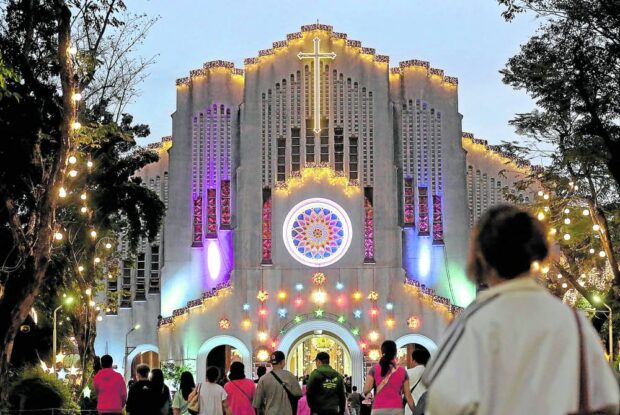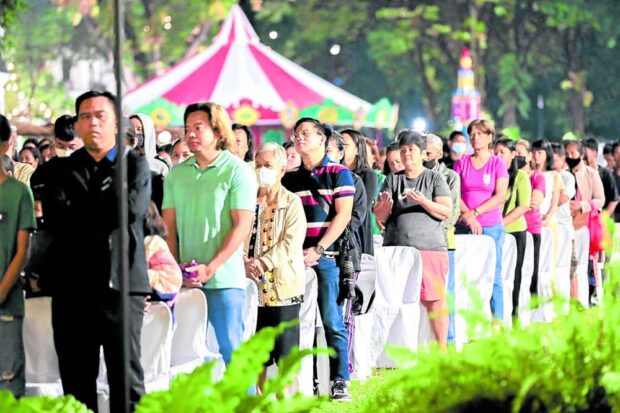
AT THE BREAK OF DAWN Baclaran Church at the start of nine-day “Simbang Gabi” on Dec.16 —RICHARD A. REYES
Merry Christmas Eve!
Today marks the 9th day of the “Simbang Gabi” tradition. If you completed all nine days, congratulations!
At the Mary Mother of Hope Chapel in Landmark, the Simbang Gabi mass I was able to attend was presided by His Eminence Cardinal Jose Advincula. The following day it was presided by His Excellency Archbishop Charles John Brown, Apostolic Nuncio to the Philippines.
In his homily. Cardinal Advincula talked about the origins of Simbang Gabi. He said, “Alam niyo ba na ang misa de gallo ay misa ng manok? (Did you know that misa de gallo is mass of the chicken?)” I instantly thought of chicken for dinner but he was referencing the vivacious rooster (so maybe it can also be translated to misa ng tandang) as misa de gallo is Spanish for rooster’s mass. The Cardinal explained that the mass was held at the crack of dawn—around the time that the rooster would start to crow—to accommodate farmers who were too tired to attend evening masses but who needed to be at the field early in the morning as well.
Through the centuries, however, the misa de gallo has come to refer to the culminating mass for all the dawn masses, i.e, the midnight mass on Christmas Eve. Meanwhile, the dawn masses—Simbang Gabi—are called misa de aguinaldo, to highlight that the act of waking up very early, while a sacrifice, is a gift or aguinaldo.
We really must consider it a gift because the Simbang Gabi actually does not correspond to the liturgical calendar. So the truth is it need not be held. It is a privileged votive mass. Msgr. Reginald Malicdem explained that the nine masses are considered novena masses for the Blessed Virgin Mother and have a special liturgy, with the priests wearing white vestments and the Gloria allowed to be sung. An old article of Bishop Rex Alarcon also explains, “The spirit of the Mass is that of anticipation for Christmas, like Mary expecting the Birth of her Son, Jesus.” So it is a beautiful tradition wherein the faithful spiritually journey with Mary, the very brave expectant mother, as she prepares to enter into the mystery of the birth of the Son of God into the world.
From being held simply for farmers, it became a festive tradition. Back when there was no electricity, the Simbang Gabi masses were announced by the ringing of church bells, with a marching band going around town playing Christmas music and the priests even knocking on doors to wake up the faithful to attend the mass. The faithful would then walk to church using lanterns as their light, which later became a symbol of the star that the Wise Men followed, and the locals would come up with designs and hang the lanterns proudly on their windows after mass. This became the basis for the parol or Filipino Christmas lantern.

THE PALACE IS OPEN President Marcos opened the Malacañang grounds to the public for the traditional dawn masses this Christmas season. The public can also view the Christmas tree and lanterns along the Kalayaan grounds. —Malacañang photos
Yuletide food
Of course, the tradition also involves food! To make Archbishop Brown, who hails from New York, fully experience the Filipino Simbang Gabi tradition, Mr. Teddy Keng of Landmark—who has made it his mission to include a chapel in all the malls he builds—hosted the nuncio at Via Mare, which has a branch at the mall serving traditional Simbang Gabi fare such as bibingka and puto bumbong.
Bibingka is a rice cake, although much flatter in shape than a cake, made from freshly milled rice (galapong), coconut milk and water. Rice grains are soaked overnight before being ground in stone mills and combined with water or coconut milk to form a batter, which would then be cooked in a special clay pot. (Today, it is easier to make this using rice flour instead of soaking rice grains overnight.) The ingenuity of Filipinos can be seen here as obviously, they did not have baking ovens. What they did was line the bottom of the pot, which was fired using charcoal, with banana leaves. Then to create the function of an oven, the top of the bibingka mixture would be covered in banana leaves as well, with charcoal placed on top of the leaves for heat.
Another ingenious creation is the puto bumbong. Puto is also a Filipino rice cake but this version—‘bumbong’— is steamed in a bamboo tube. It is made using an heirloom variety of glutinous rice called pirurutong, which is deep purple to black in color (as opposed to regular rice, which is white), hence the purple color (although today some use purple flour or even food coloring) of this delicacy. Pirurutong grains are covered in water and soaked overnight, drained and then packed densely into the margarine-greased bamboo tubes and steamed (like the bibingka, this also uses a special cooking gadget with the bamboo tubes). The result is the tube-shaped rice cake, usually two pieces as each machine has two tubes, served on banana leaves with a slice of butter, grated coconut and muscovado sugar on top.
Other rice cakes are also served for Christmas such as the traditional puto, various varieties of suman and palitaw. But bibingka and puto bumbong are the most popular, especially because these are actually sold right outside church after the dawn masses.
If you are to enjoy these at home, these are usually paired with traditional Filipino hot chocolate—the thick kind. I explained to Archbishop Brown that this hot chocolate was introduced to Filipinos by Spanish friars and immortalized in the book Noli Me Tangere of national hero Jose Rizal:
Every time scandals reached Father Salvi’s ears, he smiled and crossed himself, immediately reciting Our Father. They called him a watchdog, a hypocrite, a Carlist, a miser. Padre Salvi would only smile to himself and pray more. The Alferez always told the few Spaniards who visited him the following anecdote:
“Are you going to the convent to visit that little dead fly of a priest? Careful! If he offers you chocolate, which I doubt he will … but if he finally offers, be on guard. If he calls the servant and tells him: ‘Juan, make a cup of chocolate, eh?’ Then you can stay and not worry; but if he says ‘Juan, make a cup of chocolate, ah?’ then pick up your hat and exit running.”
“What?” Asked the other man fearfully. “Does he dole out poison? Good heavens!”
“Man, no; not to that extent.”
“So?”
“Chocolate eh? means espreso, thick; and ah means aguado, watered down.”
Others enjoy the rice cakes with salabat (ginger tea) or coffee.
In our small town of Sta. Maria in Bulacan, we enjoy the tsokolate with pandesal or salt bread. This was introduced around the time the misa de gallo was introduced to the country. We dip the pandesal in the tsokolate.
A more exquisite enjoyment of the tsokolate would be to pair it with ensaimada, a Filipino brioche topped with quezo de bola.
The misa de gallo is followed by noche buena, which is a real feast! This is usually where families serve Christmas ham, which is glazed so the savoriness of the ham is punctuated by the sweetness of the glaze. If you are a big family, there is usually lechon. Other traditional noche buena menus include chicken galantina, roast beef or beef morcon and paella. For dessert, there are usually fruit salad, fruit cake, or the Cathedral Window Gelatin, which is inspired by the stained glass windows of cathedrals.
Whatever you have on your table tonight, even if it’s just delicious sleep on the menu, let’s give thanks for our greatest aguinaldo, the gift of Christ. Merry Christmas!!

